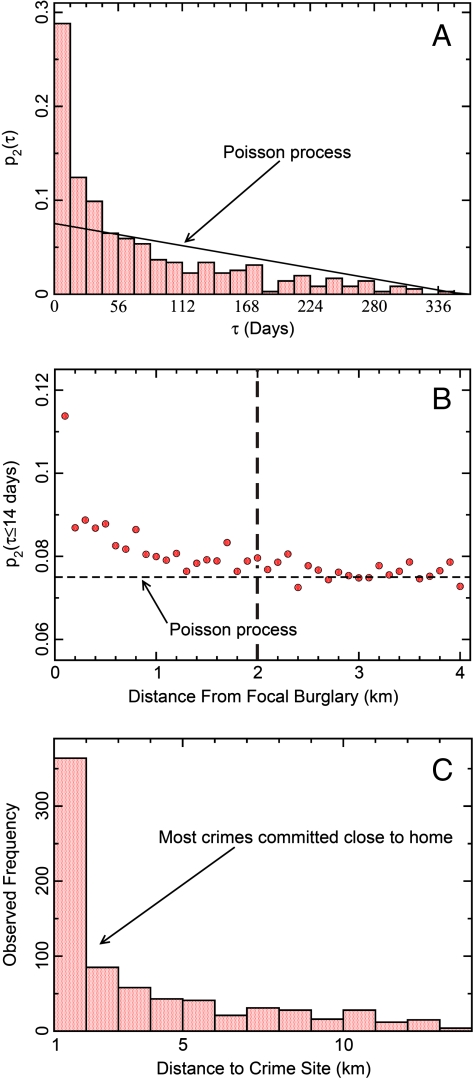Fig. 1.
Spatio-temporal patterns of criminal behavior. Criminal offenders are more likely to return to the same and/or nearby locations to commit repeat crimes. Here we illustrate this fact through the specific example of single-family residential burglary, using data from Long Beach, California, over the years 2000–2005 (SI Empirical Crime Data). (A) The probability of observing a time separation of τ days between events at individual residences burgled exactly twice within a fixed temporal window of D = 364 days. We compare the observed distribution with an expected distribution of repeat crimes assuming they are Poisson distributed in time: p2(τ) = 2(D - τ)/D(D + 1) (21). Repeat burglaries are much more likely to occur in the four weeks following the initial event than by chance, suggesting that burglars are biased to return to the same locations because of unique environmental cues and/or specific knowledge gained in the first burglary. (B) Repeat burglary probability in the two weeks following an initial crime as a function of distance from the initial crime. The Poisson expectation is calculated as  . Burglaries occurring within two weeks of one another separated by more than approximately 2000 m are statistically independent (Poisson), whereas those that are closer to one another in space show strong spatial dependency; the interpretation is that the initial burglary increases the likelihood that neighbors are also victimized. Crime risk therefore spreads spatially up to distances ≤ 2000 m (dashed line). Similar repeat and near-repeat victimization dynamics are recognized for shootings (19) and insurgent attacks (23), indicating that these are generic features of a wide range of crime types. (C) Journey-to-crime distribution for residential burglars measured as the distance in kilometers from the offender’s residence to the site of a burglary. Most offenders search for targets in the immediate vicinity of home, a key activity node in their daily routine.
. Burglaries occurring within two weeks of one another separated by more than approximately 2000 m are statistically independent (Poisson), whereas those that are closer to one another in space show strong spatial dependency; the interpretation is that the initial burglary increases the likelihood that neighbors are also victimized. Crime risk therefore spreads spatially up to distances ≤ 2000 m (dashed line). Similar repeat and near-repeat victimization dynamics are recognized for shootings (19) and insurgent attacks (23), indicating that these are generic features of a wide range of crime types. (C) Journey-to-crime distribution for residential burglars measured as the distance in kilometers from the offender’s residence to the site of a burglary. Most offenders search for targets in the immediate vicinity of home, a key activity node in their daily routine.

